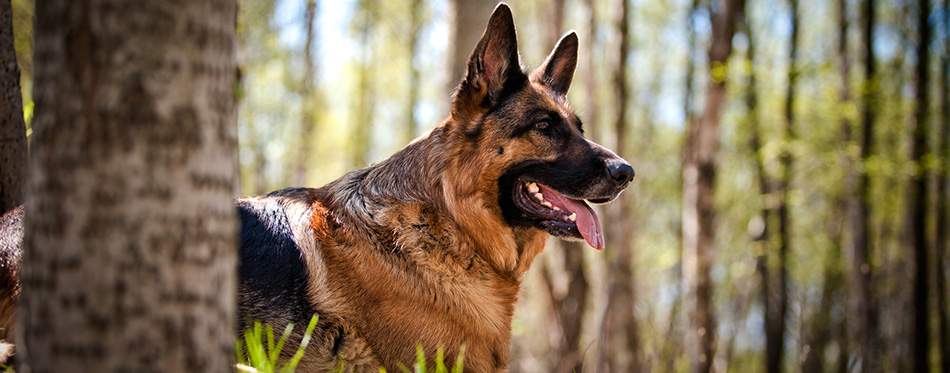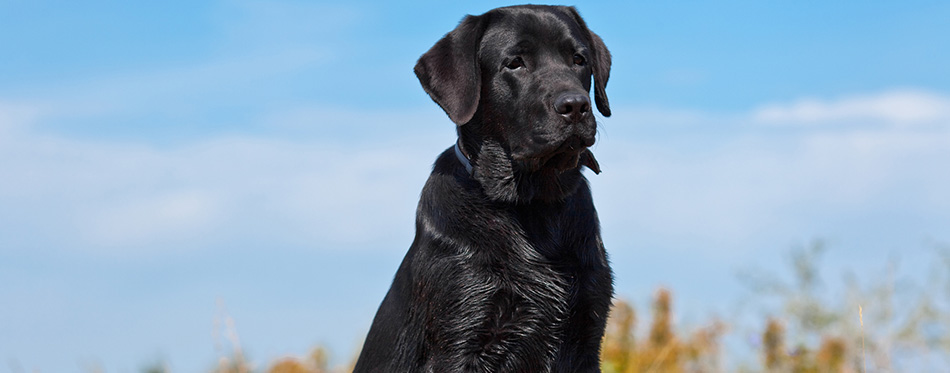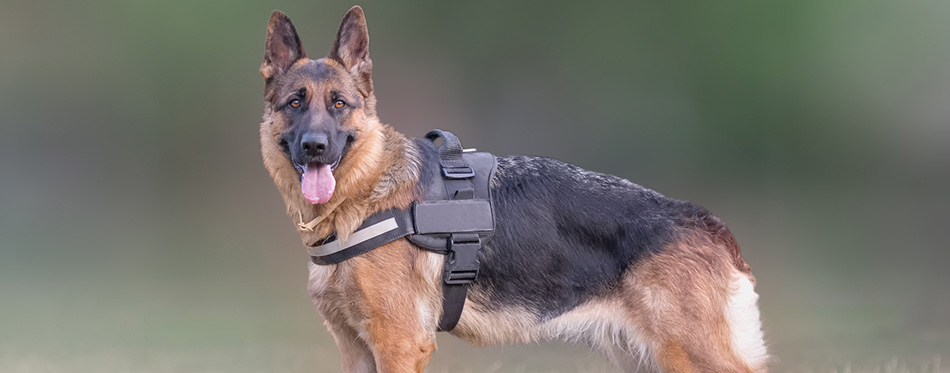Shepradors are indeed wonderful dogs that for some people will make the perfect canine companion. However, notice our emphasis on “some” – a Sheprador deserves an active lifestyle and lots of attention. If you cannot provide this standard of living for them, we urge you to find your perfect pooch elsewhere. However, if you follow an active lifestyle and spend most of your evenings at home, a Sheprador is for you. Read on to find out more about these treasured canines below!
History of the Sheprador
For such a uniquely brilliant dog breed, the history of the Sheprador isn’t as extraordinary. The breed was produced alongside the hordes of designer dogs in the 90s in America. Breeders wanted to offer their customer base variety as well as attempt to create hypoallergenic breeds for dog-lovers who suffered from allergies. Advocates of the designer dog trend believe that most designer canines are free from the hereditary traits such as hip dysplasia that affect larger purebred dogs. Although the American Kennel Club refuses to acknowledge the Sheprador breed due to their designer dog status, the breed is recognized by both the International Designer Canine Registry and the Dog Registry of America.

Who are the Parents?
The Sheprador’s parents are two of the most popular dog breeds in America: the Labrador Retriever and the German Shepherd. We’re convinced that you’ll have heard about both lovable breeds before now, as both are renowned for their loyalty and devotion to their families. Let’s take a look below to explore their history and discover what wonderful characteristics the Sheprador gained from both sets of parents.
German Shepherd
Best described as quintessential working dogs, German Shepherds are a loyal and intelligent breed. Many male dogs of this breed boast a height of twenty-three inches, which unfortunately results in the breed being feared by many small children. However, it is this same upright and alert stance that musters fear in robbers, too. A purebred German Shepherd will be remarkably intelligent; especially in terms of emotional intelligence as many German Shepherds can muster the emotion of empathy when a member of their family is upset. Although children may be intimidated by their noble stature, a typical German Shepherd will adore having children to protect and nurture around the house and will never tire of their games.
The breed’s origins are certainly unique. Horand von Grafrath was the first official German Shepherd who belonged to Max von Stephanitz, the founding father of the German Shepherd breed. Von Stepanitz first laid eyes on von Grafrath at a dog show and fell head over heels for his high levels of obedience and intelligence. Thus, he decided to make him his canine companion. Horand was then exhibited to breeding programs in the Phylax Society who wished to standardize dog breeds in Germany, who were likewise taken by the Shepherd’s sheer devotion to his master. The moment that Horand was registered under a new breed registry at the start of the 20th century marked the beginning of the beloved German Shepherd breed. Horand fathered many pups who each inherited the ideal characteristics of loyal working dogs and became the first generation of German Shepherds.
Сheck out our detailed review of Dog Food for German Shepherds for more options.
Labrador Retriever
There aren’t many dogs as wonderful as Labrador Retrievers. Boasting a kind and loving temperament, they’re widely acknowledged as one of America’s most beloved dogs. However, although the number Labrador Retrievers has blossomed in America, it is speculated that the breed firstly originated in Canada around the 1830s.
Their quick adeptness as puppies to training is why the Labrador Retriever breed constitute approximately 60% of guide dogs. Other fields these working dogs tend to enter are tracking and detection roles. From entering bomb squads to working with the local police, the skills of a quintessential Labrador Retriever are unparalleled in scope. However, this arguably isn’t the case for Labrador Retrievers of the chocolate variety who are often lovingly described as “dim”. Either way, whatever color of Labrador Retriever you choose, they’re one of the best companions you could find. Our Sheprador friends are lucky to possess even an ounce of their loving and caring temperament.
Head over to our review of Dog Food for Labs for more alternatives.
Quick Facts
- The Sheprador also has another name: If the breed name Sheprador doesn’t float your boat, you can join the handful of dog-lovers who refer to the breed as Labrashepherds! Personally, we believe the name Sheprador rolls of the tongue a little more naturally.
- A Sheprador’s tail will either be fluffy or flat-haired: How fluffy your Sheprador’s tail is will entirely depend on whether he takes after his German Shephard or his Labrador Retriever parent!
- Dogs of this breed are awful for allergy sufferers: A Sheprador isn’t the best type of dog to bring into your home if a member of your family suffers from allergies. Their medium length coats are much like their German Shepherd parent; dense and prone to shedding.
- They’re expensive to purchase: Considering the popularity of its pet parents, it’s not a huge surprise that Shepradors are expensive. Costing around $800, to acquire a Sheprador isn’t cheap. However, trying to bring down the price by contacting sketchy breeders will come back to bite you. These breeders neither care about the health of your pup nor the future of the Sheprador breed and should be avoided at all costs.

Things You Should Know
Like what you hear so far? We’ve discussed the quirks of this loveable breed in greater depth below, so you can find out for sure if you’re ready to welcome a Sheprador into your home.
Training
The average Sheprador couldn’t be more trainable. Positive reinforcement training should commence as soon as your German Shephard Labrador mix enters your home to deter any unwarranted behaviors from arising in the future. A particular style of positive reinforcement training that works well for Shepradors is clicker training – a reward-based method by which your dog learns to associate the click with a reward to praise good behavior. In time, the click itself will become your Sheprador’s reward as they learn to identify it as praising them for being a “good dog”.
Feeding
Although their designer dog status means there isn’t exactly a quintessential Sheprador, if there was, they would love to eat. A German Labrador mix will try every trick in the book to coax their owners into giving them treats; whether that’s pining with their innocent doe eyes or sitting up in the perfect “sit” position to show that they’re being a “good dog”. To this end, it’s highly important that a Sheprador’s meal portions are weighed out before they’re fed to keep them at a healthy weight. Like their Labrador parents, Shepradors are prone to rapid weight gain due to their love of food.
Regarding their feeding schedule, a Sheprador thrives when fed two times per day. If their portion sizes are large, it’s much more difficult for a Sheprador to gobble up their food in a matter of seconds. If your Sheprador is a real starver, spreading their mealtimes out from two to three portions per day may be beneficial to curb their hunger.
For more guides on choosing the right dog food, you may wish to check out our reviews of the best dry dog food, organic dog food, food for diabetic dogs, dog foods for sensitive stomachs and puppy food.
Exercise
Exactly like their active parents, it’s imperative to a Sheprador’s health that they’re taken out for at least an hour per day – and will particularly thrive if walked for an hour and a half. If taking them out for this long isn’t feasible, why not replace walking time with a game of fetch? Your Sheprador will doubtlessly love the one-on-one time spent together and the chance to run rabid whenever you throw the ball.
Related Post: Dog Balls
Socialization
Whatever kind of dog you own, socializing them is crucial so they turn out to be the best version of themselves possible. As soon as your Sheprador puppy has received all their vaccinations at around thirteen weeks of age, you should muster every ounce of effort in you to ensure they’re socializing with other dogs. Proper socialization becomes even more important if you believe your Sheprador has inherited more German Shepherd genes than their Labrador parent’s, as German Shepherds have the tendency to be stand-offish with other dogs.
Therefore, contact an owner of a dog you trust and invite them round to play with your Sheprador pup. As well as the act of playing with another puppy or tolerant adult dog being a huge step for your Sheprador pup, it’s also a huge step for you as their owner. Therefore, don’t worry if you can feel yourself being overwhelmed at times – this is a perfectly natural part of the process. Try to remember that roughhousing is a huge element of play, so expect light and good-natured play-biting, chasing, and even lunging to ensue.
Grooming
If your Sheprador pup takes after their Labrador parent, their grooming needs should be minimal. On the other hand, if they’ve inherited the hair of their German Shepherd parent, prepare yourself for a world of pain. Purchase a de-shedding tool so, when springtime rolls around to mark the unofficial start of grooming season, you’ll have the tools at your disposal to stop your Sheprador from filling your home with a torrent of hair. Our 2020 guide will help you identify the best dog shedding brush to meet your Sheprador’s undercoat grooming needs, although it’s hard to beat the classic FURminator.
For more help on dog grooming, you may wish to read our guides on the best dog nail grinders, dog dryers, dog clippers, dog paw washers and dog shampoo.
Health
Although members of the Sheprador breed generally keep in good health – boasting an average life expectancy between 10 to 14 years – many Sheprador pups are unfortunately predisposed to health problems that their parents suffer from. Accordingly, you must learn to identify the symptoms of these conditions before you purchase a Sheprador, so you can act faster.
- Hip dysplasia: This hereditary orthopedic condition has been known to present itself in Shepradors from as early as four months, although rapidly growing dogs between six and twelve months of age are mostly diagnosed. If you start to notice your small Sheprador “bunny hopping” (as in moving their back legs simultaneously), having difficulty moving up and down, and not wanting to go for a walk, we recommend taking them to the vet so they can properly diagnose your dog and alert you to the treatment methods that will be most suitable.
- Bloat: We humans think of bloat to be when your stomach swells up like a balloon after eating a hearty meal. Yet for dogs, bloat – otherwise referred to as gastric dilatation-volvulus) is something entirely different and constitutes a medical emergency. If bloat occurs, the stomach fills with gas and twists, thereby cutting off the blood supply to the gut and stopping any food from leaving. This situation becomes even more serious if the spleen twists and consequently blocks veins that transport blood to the heart. If your Sheprador has any symptoms of bloat including but not limited to a swollen, hard belly, drooling, and severe pain in the abdomen, you must take them to a vet immediately.

Temperament
As one of the best family dogs, the Sheprador boasts an even, docile temperament and is relaxed when around the house. When the opportunity presents itself, however, they’ll be right in the middle of the fun, not wanting to miss a single moment. The Sheprador loves nothing more than the chance to show off its training and thrives off attention – and treats, of course!
Shepradors don’t fare well when left alone for long periods of time. That’s why it’s important these dogs are welcomed into families that either work near their home or work from home, as leaving them for long periods of time will provoke a Sheprador’s separation anxiety. However, staying with your Sheprador won’t exactly be a chore. Given a Sheprador’s zest for life and easy-going attitude, you’ll most likely find your own outlook on life becoming more positive just by spending time with your German Shephard Labrador mix. With the correct amount of socialization and training, it’s hard to find a better breed of dog than the Sheprador – if not impossible.

